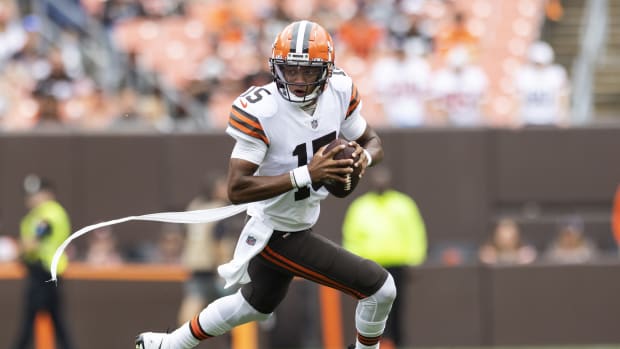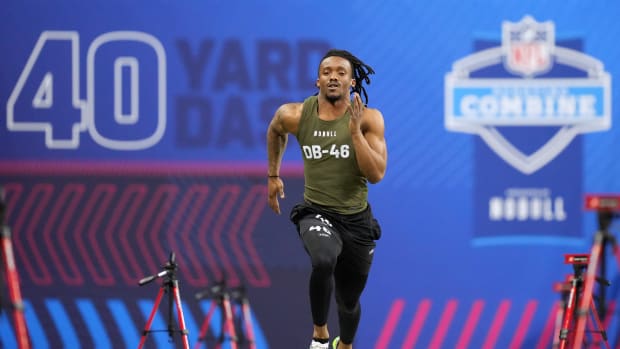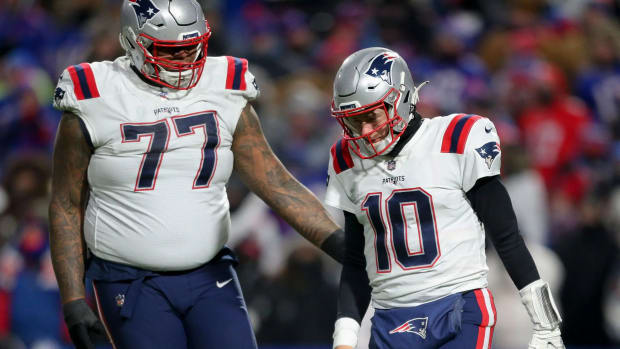SI:AM | The Biggest Deals of NFL Free Agency (So Far)
Good morning, I’m Dan Gartland. With Aaron Judge and Gerrit Cole both undergoing MRIs this week, is it too early to start freaking out about the New York Yankees?
In today’s SI:AM:
⛹️♂️ Men’s conference tournament preview
If you’re reading this on SI.com, click here to subscribe to receive SI:AM in your inbox every weekday.
We’re just getting started
Yesterday marked the true start of the NFL’s free agency period—and it didn’t disappoint.
While players can’t officially sign new contracts until the start of the new league year on Wednesday at 4 p.m. ET, yesterday marked the beginning of the legal tampering period when players are allowed to agree to deals. Let’s run down a few of the biggest moves.
Kirk Cousins to the Falcons
Cousins’s deal is for four years and up to $180 million, with $100 million guaranteed.
Cousins was the top player available in Gilberto Manzano and Matt Verderame’s rankings, even though he’ll be 36 and is coming off a torn Achilles tendon. He’s an above average quarterback who has flashes of excellence (like his league-leading eight game-winning drives in 2022), which is something the Falcons haven’t had since Matt Ryan retired after the ’21 season.
The Cousins signing will mark the end of Desmond Ridder’s time as Atlanta’s starter and, coupled with the arrival of new coach Raheem Morris, will give the team an opportunity to start fresh. Cousins brings experience to an offense with an appealing level of young talent, including running back Bijan Robinson, receiver Drake London and tight end Kyle Pitts. Playing in a division without a clear top team, the Falcons now have the missing piece that could lead them to the playoffs for the first time since 2017.
Saquon Barkley to the Eagles
After playing last year under the franchise tag, Barkley finally got what he wanted: a long-term deal. It’s a three-year deal worth $26 million guaranteed and up to $46.75 million with incentives. That’s a whole lot more than the $12.1 million he would have earned if the New York Giants chose to use the tag on him again.
So it’s a good deal for Barkley, but what about for the Philadelphia Eagles? Paying a premium for a running back is always risky, and especially so with a player with Barkley’s injury history. After winning the Offensive Rookie of the Year in 2018, ankle injuries and a torn ACL severely limited his availability and effectiveness in the next three seasons, but he bounced back with a great ’22 season (1,650 total yards). He took a step backward this season, though, rushing for 964 yards and averaging just 3.9 yards per carry as the Giants limped to a 6–11 finish. The positive is that Barkley has remained mostly healthy over the past two seasons. He ranks third in the NFL in total carries during that period (behind Derrick Henry and Josh Jacobs). But that’s a double-edged sword. In his seventh season, what level of durability can the Eagles anticipate from a running back shouldering such a workload?
Brian Burns to the Giants
New York made a major move to upgrade its defense, trading for Carolina Panthers pass rusher Brian Burns and subsequently inking him to a massive contract extension. (Carolina had placed the franchise tag on Burns last week.) His new deal is for five years and up to $150 million, with $87.5 million guaranteed. In return, the Panthers get a second-round pick in this year’s draft and a fifth-round pick next year. Burns, a two-time Pro Bowl selection who has 46 career sacks in five seasons, will form a formidable pass-rush duo with 2022 first-round pick Kayvon Thibodeaux, who had 11.5 sacks this season.
Michael Pittman Jr. stays with the Colts
Pittman’s short-term future in Indy was never really in doubt. The Indianapolis Colts used the non-exclusive franchise tag on him last week to increase the chances that he would remain with the team for at least one more season. By reaching an agreement on a three-year, $70 million contract ($46 million guaranteed), the Colts have ensured that he’ll be around for the foreseeable future.
Pittman has been a reliable target for a litany of so-so Colts quarterbacks during his time with the team. He’s averaging more than 1,000 yards per season over the last three years, despite catching passes from guys like Carson Wentz, a washed-up Matt Ryan and Gardner Minshew. The Colts have high hopes for quarterback Anthony Richardson, the No. 4 pick last season, and having a dependable top receiver like Pittman is crucial to his development.
The best of Sports Illustrated
- Matt Verderame and Gilberto Manzano are grading all the notable free agency deals as they roll in.
- Allowing Saquon Barkley to leave is a necessary part of the Giants shedding the remains of the Dave Gettleman era, Conor Orr writes.
- Orr also wrote about Kirk Cousins once again managing to get a great contract for himself, despite not being a top-tier quarterback.
- Pat Forde’s latest Forde Minutes column previews the major men’s conference tournaments that begin this week.
- Emma Baccellieri was in Las Vegas last week, where fans said farewell to the Pac-12 at the conference’s final women’s basketball tournament.
- Kobe Bryant’s statue outside the Lakers’ arena includes several misspelled words.
- The Yankees got some worrisome news yesterday when ace Gerrit Cole was sent for an MRI after complaining of elbow soreness.
The top five...
… things I saw last night:
5. The precision passing by the UConn women on this bucket early in their Big East championship game victory over Georgetown.
4. Luka Dončić’s seventh straight triple double.
3. Shay Holle’s clutch three to put Texas ahead late in the Big 12 women’s semifinals against Kansas State.
2. Samford men’s coach Bucky McMillan’s press conference after leading the Bulldogs to their first NCAA tournament in more than 20 years. McMillan was hired four years ago with no prior college coaching experience and has now won at least 20 games in each of the past three seasons. Pat Forde wrote about the school’s daring move back when he was hired in 2020.
1. Trayce Jackson-Davis’s poster dunk on Victor Wembanyama.
SIQ
On this day in 2003, Damian Constantino’s NCAA-record 60-game hitting streak came to an end. What school did he play for?
- Rutgers
- Truman State
- Salve Regina
- Arkansas Tech
Yesterday’s SIQ: On March 11, 1901, The Cincinnati Enquirer reported that which American League team was considering signing a Native American player named Tokohoma (who in reality was a Black baseball star named Charlie Grant)?
- Detroit Tigers
- Baltimore Orioles
- Philadelphia A’s
- Washington Senators
Answer: Orioles. (This was a different Orioles franchise than the one that exists today.) Hall of Fame manager John McGraw had wanted Grant to be his team’s second baseman, but with baseball’s color line still more than 40 years from being broken, he couldn’t sign a Black player. So McGraw concocted a story that Grant was a member of the Cherokee tribe named Tokohoma.
As Grant’s Society for American Baseball Research biography lays out in great detail, the subject of his true identity was a source of much speculation. Chicago White Sox owner Charlie Comiskey apparently played a major role in uncovering Grant’s true identity. Grant had played with the Columbia Giants, a pre-Negro Leagues team of Black players based in Chicago, and Comiskey recognized him as the man McGraw said was a Cherokee.
With the gambit exposed, Grant never played for the Orioles. He returned to Chicago and continued playing with Columbia. He played professionally until 1916.






































